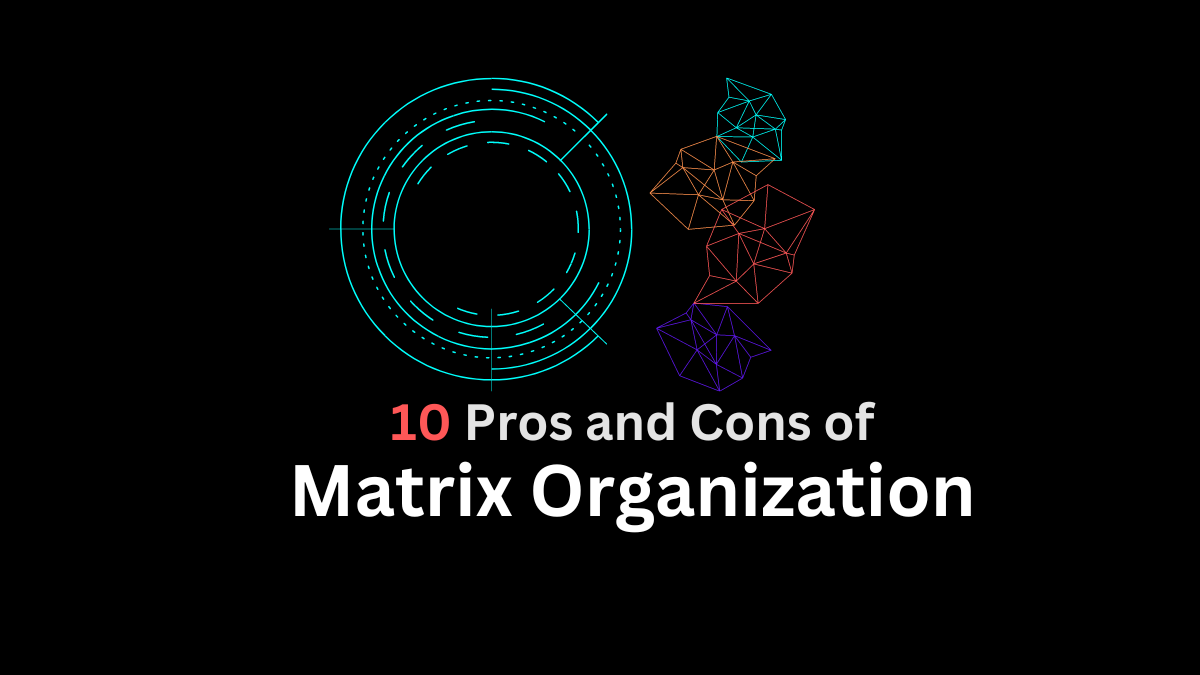Pros and Cons of Matrix Organization
A matrix organizational structure is characterized by a dual reporting system where employees report to both functional and project managers. This setup facilitates the sharing of knowledge and skills across different parts of the organization, fostering better problem-solving and innovation.
Here we will discuss 10 major pros and cons of matrix organization in business, so let’s start:
Pros of Matrix Organization
Let’s explore the five key benefits of matrix organizational structure in the workplace:
Enhanced Communication and Collaboration
The matrix structure facilitates open communication across different departments, as employees report to multiple managers and collaborate on projects. This setup encourages knowledge-sharing and teamwork, leading to innovative solutions and efficient problem-solving.
By breaking down traditional silos, employees can leverage diverse expertise, resulting in improved decision-making and a more integrated organizational approach.
Resource Flexibility and Efficiency
One of the significant advantages of the matrix structure is the efficient utilization of resources. Employees can be assigned to projects based on their skills and expertise, allowing the organization to allocate resources where they are most needed.
This flexibility ensures that highly skilled individuals contribute to multiple projects, maximizing their potential and reducing downtime. It also allows for the optimal use of specialized talent without the need for dedicated project teams, making it cost-effective.
Professional Growth and Development
The matrix structure provides employees with opportunities to work on various projects beyond their primary functional roles. This exposure to different challenges and responsibilities fosters professional growth, as employees gain diverse experiences and develop new skills.
The continuous learning environment enhances job satisfaction and motivates employees to perform at their best, ultimately benefiting the organization through a more capable and versatile workforce.
Improved Risk Management
By bringing together employees from different functional areas, the matrix structure enhances risk management. Cross-functional teams can identify, assess, and address potential risks more effectively due to their diverse perspectives and expertise.
The dual reporting lines add an extra layer of oversight, making it easier to monitor and mitigate risks. This collaborative approach helps organizations navigate complex projects and avoid costly setbacks.
Read More: 10 Major Pros and Cons of Job Enlargement
Faster Project Delivery
The matrix structure allows for quicker project completion due to its efficient resource allocation and streamlined communication. Project managers can assemble teams with the necessary skills and expertise, expediting decision-making and reducing project timelines.
The enhanced collaboration and open communication channels help avoid common bottlenecks and hurdles, ensuring projects are delivered on time and within budget.
Cons of Matrix Organization
Now, let’s explore the five main disadvantages of matrix organizational structure:
Complex Reporting Relationships
The matrix structure introduces complexity by requiring employees to report to multiple managers, often leading to confusion about roles and responsibilities.
This dual reporting can create ambiguity in decision-making and performance evaluations, making it challenging for employees to prioritize tasks and for managers to maintain clarity in their directives. The added complexity can slow down processes and hinder productivity if not managed effectively.
Read More: 10 Major Pros and Cons of Line Organization
Potential for Conflict
With multiple managers overseeing the same employees, there is a high potential for conflicts and power struggles. Differing priorities and management styles can lead to disagreements, impacting team cohesion and project outcomes.
Without clear communication and conflict resolution mechanisms, these disputes can escalate, causing delays and reducing the overall effectiveness of the organization.
Increased Workload and Stress
Employees in a matrix structure often face increased workloads due to their involvement in multiple projects simultaneously. This can lead to higher stress levels and potential burnout, particularly if the workload is not evenly distributed or if employees are expected to meet conflicting demands from different managers.
Overworking key employees can also result in higher turnover rates, as individuals seek less stressful work environments.
Read More: Pros and Cons of Functional Organization
Slow Decision-Making
Decision-making in a matrix structure can be slow due to the need for multiple managerial approvals. The dual reporting lines mean that employees often have to consult with both their functional and project managers before taking action, which can delay critical decisions and hinder the organization’s ability to respond quickly to market changes or emerging opportunities. This bureaucratic process can be frustrating for employees and detrimental to the organization’s agility.
Resource Allocation Challenges
While the matrix structure aims to optimize resource utilization, it can also lead to challenges in resource allocation. Managers may compete for the same high-performing employees, leading to potential conflicts and inefficiencies.
Additionally, if managers hoard their best resources for departmental priorities, it can limit the availability of skilled individuals for critical projects, ultimately affecting project quality and delivery.
The matrix organizational structure offers significant benefits, including enhanced communication, resource flexibility, professional growth, improved risk management, and faster project delivery. However, it also presents challenges such as complex reporting relationships, potential conflicts, increased workloads, slow decision-making, and resource allocation issues. Hence, the above listed present the 10 main pros and cons of matrix organization in the workplace.
